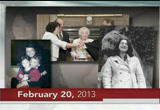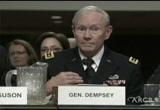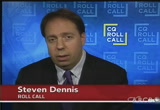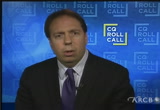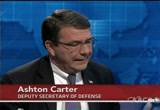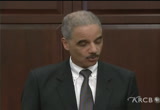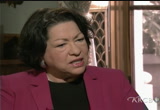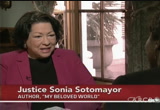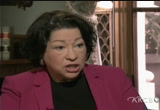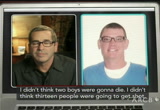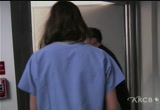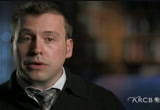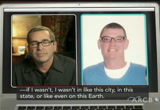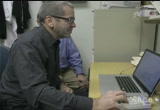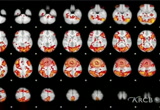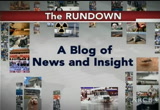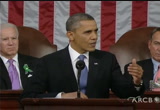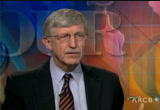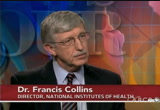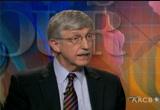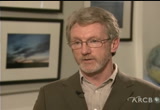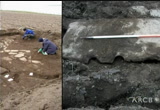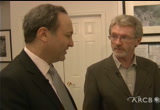tv PBS News Hour PBS February 20, 2013 10:00pm-11:00pm PST
10:02 pm
captioning sponsored by macneil/lehrer productions >> ifill: defense secretary leon panetta warned today he may furlough the vast majority of the department's 800,000 civilian workers, if automatic spending cuts take effect. good evening, i'm gwen ifill. >> woodruff:nd i'm ju woodff. on the "newshour" tonight, we assess the sequestration threat and zero in on the defense cuts with deputy secretary ashton carter. >> ifill: then, we have a conversation with justice sonia sotomayor-- the first hispanic member of the supreme court about her life before and on the bench. >> sort of fine walking that we're always doing between when are we listening with an open
10:03 pm
mind and when has our mind been closed because of a bias? >> woodruff: plus, we have two medical research stories. first, our week long focus on guns. "after newtown" continues, with a report from miles o'brien on what science can tell us about the minds of rampage killers. andy williams called me collect inside the prisop. >> i didn't think 13 people were going to get shot. i just thought i'd make a lot of noise and the cops would show up. >> ifill: francis collins, head othe national instituteof health, walks us through president obama's call for a ten-year initiative to map the human brain. >> woodruff: plus, jeffrey brown reports on an archaeological find in the orkney islands off scotland that may provide new insight into religious practices in the neolithic age. >> ifill: that's all ahead on tonight's "newshour." >> major funding for the pbs newshour has been provided by:
10:04 pm
>> and with the ongoing support of these institutions and foundations. and... >> this program was made possible by the corporation for public broadcasting. and by contributions to your pbs station from viewers like you. thank you. >> woodruff: it was the starkest statement yet on the possible effect of automatic federal budget cuts, due to begin in nine days, on march first. defense secretary leon panetta notified his entire civilian work force that employees could be sent home without pay.
10:05 pm
the warning was aimed at defense department workers at the pentagon and around the world. secretary panetta sent them a written message, as he left for a nato defense ministers meeting in brussels. in it, he said there are limited options for coping with the looming across-the-board cuts. and, he said: >> on our civilians it will be catastrophic. >> woodruff: within hours, top pentagon officials were out, saying employees could lose one day of work per week for 22 weeks. civilians will experience a 20 percent decrease in their pay between late april and september. as a result, many families will be forced to make difficult
10:06 pm
decisions on where their financial obligations lie. >> reporter: the furloughs could start in late april and save roughly $5 billion. uniformed personnel at war would be exempt, but in a letter to congress, panetta wrote that the spending cuts will slow training and the procurement of weapons. the result, he said, will be a hollow force. the nation's top military leader had said as much last week at a senate hearing on the automatic cuts. chair of the joint chiefs of staff, general martin dempsey: >> this would be the steepest, biggest reduction in total obligating authority for the defense department in history at a time when i will personally attest to the fact that it's more dangerous than it has ever been. >> woodruff: in his own statement today, house speaker john boehner charged the president bears the blame for the stalemate.
10:07 pm
white house press secretary jay carney fired back that republicans are the ones who've refused to compromise. >> and it's important to understand that if they hold that position and the sequester goes into effect. it will go into effect and those americans will lose their jobs because republicans made a choice for that to happen. >> woodruff: the president wants a combination of spending cuts and increased tax revenue to prevent the sequester. republicans say they've already raised taxes, so the focus should be entirely on spending. steve dennis is white house correspondent for the newspaper "roll call." >> right now, the republican leadership is saying absolutely nothing, they will allow absolutely nothing, no new revenue. and the white house is saying they're not going to sign anything that doesn't include new revenue. it's just, you know, it's a game
10:08 pm
of chicken right now. >> woodruff: and it won't be just ships, planes and troops affected. domestic spending will absorb the other half of the $85 billion in mandatory cuts. the obama administration has warned that, among other things: 70,000 students would be removed from head start; air travel would be slowed as air traffic controllers are furloughed and benefits for the long-term unemployed could be reduced. but "roll call's" dennis says the cuts would not all happen at once. >> you are going to start seeing a lot of what the white house has been talking about has been basically some what vague. they say sompeop willose access to child care benefits. thousands of parents are going to lose their child care benefits for example. or get kicked off of head start. well that is not going to happen on march 1. or even march 15. >> woodruff: some republicans
10:09 pm
charge the obama administration is exaggerating the potential effects. both the house and senate are out of session until next week. they'll return just days before the march first deadline. for more on the sequestration and what it means for e u. miliry. i'm joined by deputy secretary of defense ashton carter. welcome, mr. secretary so let's just pick up with that comment from some republicans that this is exaggerated. >> well, for us in the defense department, unfortunately, it's not exaggerated. in fact, we don't want to take any of these steps. we certainly are trying to do it in the way that does the minimum damage to national security. we don't have a lot of flexibility, and we don't have a lot of time in that regard. sequester requires us to find 6 blion in the last half of the year, and then we have an additional problem with the lack of an appropriations bill, which is a particular problem for us. you put those two things together, and in some of
10:10 pm
accounts that fund training, for example, for army units, those accounts are 30% short over the year, and now we only have half the year in which to make up those savings. what that means is we're ging to protect the wars in afghanistan-- we've got to nund them. we he to fund-- ed to nd military personnel. the president exempted military personnel from sequester. so the savings need to be found where we can still find savings, which will be training units that are going to be ready for other conflicts, not for afghanistan, but that means we won't be ready for those other conflicts. that's just a mathematical fact of doing sequester. this is very damaging to national security. secretary panetta and i have been saying this and we will do verying we can do minimize the damage but it is what it is. >> woodruff: when do these
10:11 pm
decisions have to be made? you made this announcement today, and others look at it and say we have nine days until march 1. do these decisions are to be made -- >> the announcement today was about one particular item which is very important which is the need to furlough some of our civilian personnel in the department. we had to make that announcement today because we're required by law, a law that applies to the defense department, to inform congress and employees on a certain scheduled. we h to tell em today they are not immediately furloughed, but they are subject to furlough late in the year. and remember, these people are-- most people think of our employees as people who work in the washington beltway or something. they're not. most of them work outside of washington. they repair our ships. they maintain our aircraft. that's who these people are. 44% of them are veterans. and so it's a terrible thing to have to deprive them of some of
10:12 pm
their income. >> woodruf how do you choose whwould be furloughed? >> it's, unfortunately, going to have to apply to most of our employees except where there is a mission-critical exception. and the reason why it has to apply to most of our employees is that remember, we have to get-- we have sosave $46 billion, and we have to do that in every way that is legally possible. and that doesn't involve shorting the war or the troops that are immediately involved in combat. >> woodruff: let me raise another republican criticism, congressman duncan hunter, armed services committee, is saying some of the things-- the steps the defense department has taken recently, like thraig an arcraft carrier group going to the persian gulf, are done to add drama to all this. >> believe me, nobody wants to add drama to this. we want to continue to defend the country as best we can under these circumstances. so every step we take is-- is--
10:13 pm
is one that we're forced to. in the case of the aircraft carrier, there a actually several this going on the, notust the money matter, having to do with maintenance and so forth, and we were trying to make sure that we had a carrier next year and that we could continue to have a carrier there. and for that reason, we weren't going to have two carries this year. that was a more complicated decision than a money decision. everything we do, we're really trying to keep on protecting the country and delivering the defense under these circumstances. aise said, in some cases, that's notoingo be possible. >> woodruff: i is u.s. national security at stake because of what might happen? >> it is, in the following sense-- by the end of the year, as i said, two-third of our army units, active-duty army units and all of our reserve units
10:14 pm
will not be ready to fight other wars. many of our air force air units will not be ready to fight other wars. a third of our ships in the pacific will not be at sea. it's not becau they-- they're not there. the ips aren't there. it's because we can't afford to operate them because we don't have any money left in the accounts that fund them. and we have to cut account by account by account. that's what sequestration forces us to do. >> woodruff: if this gets resolved secretary carter between now and march 1, or soon thereafter, are will all these cuts go away. >> oh, yes, we would never do any of these things. it's everyone's hope that deals that cover revenues and expenditures which everybody knows is necessary that that deal can be made, if congress can come around with a deal like that that the president can sign and we don't have to take any of these steps at all.
10:15 pm
whenever that occurs -- obviously, it may not occur in the next 10 days-- whenever that occurs we'll stop doing any of these things that we've been forced to do by sequester. >> woodruff: finally, let me just raise another comment one hears from republicans who say they are friends of the pentagon on the hill, but they say, look, there are programs at the pentagon that haven't worked well, aren't efficient. >> that's crew displood and you and others should have used this as an opportunity to go ahead and trim and cut those. >> that's a very fair point. weweought totobe constantly askg ourselves what kind of defense do we need? how much should we spend? are we using our defense dollars wisely? and the answer is not in all cases are we. and, you know, that is something they think we need to constantly keep pressure on. but this is not the way to achieve that objective. and i'll give you an example. we, obviously, want to keep the costs of weapons systems down, drive them down.
10:16 pm
what happens under sequester suhave to stretch out programs, reduce the number you're buying, and that increases the unit cost. so this is at the very time they completely agree with the people you're talking about. we need to be more efficient with the defense dollar, i'm all for that. but this is not efficient use. this is economically inefficient. and destructive use. it head in just the opposite direction i think we want too. woodrf: weave nine days to go, we'll see what happens. deputy secretary of defense ashton carter, thank you. >> thank you. >> ifill: still to come on the "newshour": sonia sotomayor's beloved country; the minds of rampage killers; mapping the brain and a stone age ceremonial site. but first, with the other news of the day. here's hari sreenivasan. >> sreenivasan: former congressman jesse jackson junior pleaded guilty today to spending $750,000 in campaign funds on personal items. the illinois democrat appeared in a federal district court in washington. he had resigned from congress last november, after being
10:17 pm
treated for bi-polar disorder. jackson will be sentenced in late june. his wife sandra also pleaded guilty today, to committing tax fraud. the obama administration is launching a new strategy to fight cyber theft. the plan announced today includes a diplomatic effort to discourage intellectual property theft abroad. it also calls for better coordination to help u.s. companies protect themselves. at a washington briefing, attorney general eric holder said the damage done by economic espionage is growing. >> the stakes have never really been higher. in some industries, a single trade secret can be worth millions or even billions of dollars. trade secret theft can require companies to lay off employees, close factories, to lose sales and profits, to experience a decline in competitive position and advantage or even to go out of business. >> sreenivasan: the announcement came on the heels of a report by a virginia cyber-security firm. the findings directly accused the chinese military of hacking
10:18 pm
more than 140 companies in the u.s. and elsewhere. japanese investigators have found that a lithium ion battery in a boeing 787 damliner was wired incorrectly. that word came today from japan's transport safety board. an all nippon airways plane was forced to make an emergency landing last month when the main battery overheated and started smoking. that incident and others prompted the worldwide grounding of all boeing 787s. meanwhile, wire service reports said boeing is ready to offer a temporary fix to the battery problem. 11 scientists from the u.s., japan and the netherlands are the inaugural winners of the world's richest prize for medicine and biology. they were chosen today to receive the brethugh prize in life sciences worth $3 million each. that's more than double the amount of the nobel prize. four internet leaders, including facebook's mark zuckerberg, teamed to establish and fund the annual award. they said their goal is to focus attention on scientists doing vital research.
10:19 pm
wall street took a hit today. stocks fell on indications that the federal reserve might slow or even stop its economic stimulus efforts. the dow jones industrial average dropped 108 points to close at 13,927. the nasdaq fell 49 points to close at 3,164. those are some of the day's major stories. now, back to gwen. >> ifill: one of the supreme court's most junior members, sonia sotomayor, steps from behind the black robe to tell the story of her rise from an impoverished childhood to the nation's premier bench. the memoir is "my beloved world." i sat down with the justice after the court handed down decisions today, to talk about how her life informs her jurisprudence. justice sotomayor, welcome, thank you for joining us. >> thank you for having me here today. >> ifill: in your book you write an answer thing. you say, "i was 15 years old when i understood how it is that things break down, people can't imagine someone else's point of view." i'd like to start there. explain what you meant by that.
10:20 pm
>> i think the book does that. i was talking there, i believe, about an incident involving one of my place of work that included my aunt, because i worked in her shop. she didn't own it personally but she worked there as well. and about how they thought they were playing a prank on a family by having the supervisor call the home to tell a false story, that the husband in the home was having an affair with her. and i was in a state of shock that neither my aunt-- who i loved dearly-- or the other women-- who i respected on so many levels -- couldn't imagine what havoc they were causing in that home. and i see that repeating itself so often when people do things without imagining the intooc havg on the other person. and it was a lifelong lesson.
10:21 pm
i spend so much of my life sort of thinking about what are other people thinking? >> ifill: it certainly comes in handy for a judge. >> absolutely. but i don't think it's just for a judge. i think it's for anybody in any life situation. if you don't imagine what the person you're speaking to might be thinking, you can't anticipate highway that's person is reacting to you. >> ifill: you have now been on the court how long? >> it's my third and a half year. >> ifill: wow! >> and it's sort of-- you just said "wow. of it's what i feel each passing year. it flies by. >> ifill: i want to talk to you about your first year when you write about here in the book. i wonder if you would just read the part i outlined there. >> "the first year they faced the challenges of any new environment has always been a time of fevered insecurity, a
10:22 pm
refltive terror that i'll fall flat on my face. in some stfl imposed probationary period, i work with compulsive intensity and single mindedness until i gradually feel more confident. some of the looming panic is no doubt congenital. i often see in my reaction something of my mother's irrational fear of being unequipped for nurgs school. i have gone through the same kind of transition since becoming a judge, first on the federal district court, then on the appeals court, and finally on the supreme court." >> ifill: okay, you don't look like a person prone to terror, so tell me about that. >> bui am, gwen. just what the book describes, which is in every new experience, i'm anticipating the
10:23 pm
worse, and doing everything humanly possible to master the situation-- well, first to learn it, to understand what in my environment means and what it needs to be successful. it's not something that-- and this is what the book is talking about to every reader. we're not born anything. we're not born a lawyer. we're not born a judge. we're certainly not born a justice, which is something that justice john paul stevens reminded me during my first year on the bench one day when i was actually disclosing to him how anxiety-ridden i was about being a justice. and he jt touched upon a reality for me. he said, "sonia, none of us is born a justice. we grow into becoming one." >> ifill: have you grown into one? >> not yet, but i'm growing. >> ifill: not yet. >> not yet but i'm growing gl
10:24 pm
>> ifill: one of the things you write about is learned habits for building bridges and building bridge where's others see cassisms. >> that's also part of the lessons i share in the book, if you build bridges and not chasms, if you don't build that sort of pool in front of you, but look at ways of sort of connecting with others rather than seeing your differences, that you accomplish so much more sphwhrief that seems anathema in washington. >> i'm told it is. >> ifill: just told. >> i'm smiling because, remember, i just got to washington three and a half years ago. but i think it's really a life lesson, which is ifou approach life looking immediately at how people or situations are different, you're never going tow find a solution to a
10:25 pm
problem. >> ifill: i want to talk to you about affirmative action. it is smug support, that you speak of-- >> be careful about using that word. >> ifill: you have court cases which may come before you. >> no, it's not just that, though. >> ifill: tell me. >> it's that people approach everything in life with its worst, and i do something very different in life. trying to find the best in everything. and if you try to find the best in people, they'll usually rise up to your expectation. >> ifill: well, there is-- >> if you look for the worst, you're going to find it. there is no perfect thing. >> ifill: the reason i ask that question is that is a perfect example. some people look at affirmative action-- as it's come to be known-- and they think of it as a crutch, as a negative, as a scar. and you don't. >> well, some formed of it. if you look at some other forms of it-- quota sstems, which our court years and years ago said was a bad thing and struck that
10:26 pm
down. there are forms of anything that can be bad. but there are ways of doing almost anything that can be fozzative and good. and if you look at affirmative action, as i experienced it in the earlier parts of my years, as only a challenge to institutions, not to limit their looking to those that they we usedo. you know, everybody finds it very deeply comforting to look for people in the places that they think are going to produce the candidates they want, not realizing that there are people with the same skills, the same abilities, and perhaps the same promise in other places, then you're not going to have as much diversity if you're looking only in one little corner of life.
10:27 pm
if you're willing to say, "you ow, there are exaiblg students, capable potential employees that come from a lot of different backgrounds than the ones i'm accustomed to." well, if you think that way, that "that i have to look more broadly," then you might have a more converse population in your schools and in your workplaces. >> ifill: as you were writing this book, you were forced to kind of think about your personal beliefs and your personal upbringing and your personal grounding, and blend it with your professional path, which has been, i think without argument, fairly successful. >> thankfully. >> ifill: how do you draw that line? do you draw a line? >> do i draw a line between how i rule as a judge from my personal experiences? absolutely. every judge has to. every judge comes to the bench with personal experiences. if you assume that your personal
10:28 pm
experiences define the outcome, you're going to be a very poor judge. because you're not going to convce anybody of ur views. you have to be a judge that is able to step aside and determine when their personal bias is influencing the way they're thinking about a case. you're not a very good judge if you're incapable of that. and in fact, i have spoken previously about the fact that as judges, we have to be sensitive to that. we have to know those moments when our personal bias is seeping in to our decision making. if we're not, then we're not being very good judges. we're not being fair and impartial. but that doesn't mean that our personal experiences can't permit us and don't permit us to
10:29 pm
see arguments that others might mis. so sort of fine walking that we're always doing between when are we listening with an open mind and when has our mind been closed because of a bias? >> ifill: i have to ask you one final question which comes out of the news. during your confirmation hearings you said is that you didn't-- you thought it was a grand idea, a good idea-- you had experience with cameras in the court. now you're rethinking that, now that year actually on the bench. >> keep an open mind about everything, including that. and i haven't made up my mind finally. but i'm now beginning to see the other side of the argument. s. >> ifill: it hppedz being in the room, doesn't it? >> it certainly does, on so many different levels. >> ifill: justice sonia sotomayor, thank you so much for joining us. >> thank you. >> ifill: you can find more of my interview with justice sotomayor, including why she thinks the idea of women having it all is silly, online.
10:30 pm
>> woodruff: now, to our weeklong series on guns, violence and mental health concerns in the wake of the connecticut shootings. tonight, "newshour" science correspondent miles o'brien explores emerging questions about mental health and what may be happening in therains of rampage killers. the reporting was done as part of a broader "nova" program airing tonight. both are part of pbs's special weeklong coverage called "after newtown." >> there you go, that's it. >> andy was always real playful. >> there you go! >> he was a real kind kid. >> hi, daddy... >> reporter: how did the sweet kid in the home movies become the murder suspect on the 6:00 news?
10:31 pm
>> as you said, mostly students and parents meeting up with one another, and i'm sure so shocked they just want to see which other friends are out there. >> reporter: what made andy williams-- then 15-- walk into a boys room at santana high school in santee california and open fire on his schoolmates killing two and injuring 13. his father jeff is haunted by the question. so, he wasn't a kid that was infatuat with violence? >> no, not at all. you have the silly clown, that's the thing. you don't expect the silly clown to do something like this, to go kill people. >> reporter: the class clown. >> the class clown would be the class killer. >> reporter: the mind of a rampage killer can live behind the face of the boy next door. can science shed any light in these darkest of dark places?
10:32 pm
there is not much data to go on. from columbine through newtown, in most cases, the shooter ends up dead, either by his own hand or by police. but andy williams is one of the few living school rampage shooters. >> this call is from an inmate at a california correctional facility. >> reporter: he called me collect from a payhphone inside the ironwood prison in the middle of the southern california desert. andy williams is now 27, he has spent 12 years behind bars. take us back to that moment, and if you can tell us what was going on in your mind at the ti thawould really help us. >> um, to me it was just like a numbness at the time. you know what i mean, and like i couldn't really-- like at 15, i didn't really think like all that stuff through. i didn't think two boys were going to die. i didn't think 13 people were going to get shot. i just thought i was going to make a lot of noise and that the... and that the cops were going to show up.
10:33 pm
>> reporter: andy had moved from maryland with his dad after his parents had divorced. he was the new kid at school, and even t boys that accepted him bullied him unmercifully. so, he was really going through hell? >> he's getting tormented out as the new kid at this big school and being tormented by the older kids there. >> we're getting buzzed. >> and >> reporter: andy started drinking, smoking pot and taking prescription painkillers and he had access to a gun. he had boasted to his friends that he was planning the rampage. it is a volatile mix, but, sadly, a common one. so what separates a rampage killer from other struggling teens? is it genetics or is it something in their environment? josh buckholtz is a harvard neuroscientist searching for the biological roots of violent behavior. >> one of the most infuriating things as a scientist and as a
10:34 pm
person is this attempt to try and find some diagnostic label, some neat diagnostic box to put this person into and... and thus explain why they did this terrible, terrible thing. >> reporter: but as researchers peer into the brains of criminals using m.r.i.s, they are finding somfaulty wiring. one of these circuits connects the prefrontal cortex, responsible for higher level thinking, to the amygdala, an emotion center, which goes into overdrive whenever a threat is perceived. if the threat is not real, the prefrontal cortex will send a message to the amygdala to calm down. but if the wiring is faulty, that calming message may not get through. >> and in those folks, it seems like this circuit is broken in such a way that they're more likely to respond with greater amygdala activity and greater emotional arousal, when they think that they're being fed with some kind of threat. >> reporter: even in perfectly healthy brains, the prefrontal cortex is not fully developed in the teenage years, but the amygdala is.
10:35 pm
this is one reason why teens tend to have bigger emotional swings. now imagine a teen with the early stages mental illness. >> they are people whose mental conditions often cause them to amplify to sort of social slights that happen all the time in high school. >> reporter: katherine newman is a sociologist at johns hopkins university and author of "rampage: the social roots of school shootings." >> these are kids who are desperate to be accepted. they are not loners, they are people who are trying to join groups all of the time but their experience everyday is friction. it never works or it works. suicidal? >> reporter: did you feel suicidal? >> absolutely. it was like an eight month constant like, like i wonder if things would be better if, if i wasn't... i wasn't in like this city, in this state, or like even on this earth, so my whole grand scheme, grand plan was like scide by cop.
10:36 pm
>> reporter: andy planned a so called suicide by cop, expecting the authorities to gun him down, but he had a change of heart at the last minute dropped the revolver and surrendered. researchers say 60% of rampage shooters are suicidal before the carnage. psychologist john keilp studies suicidal people, trying to find out how their brains differ from others. >> we're looking at what's different about those people. one of the things i think we feel confident about is that there is something different about those people, thait's not just a feature of depression. >> take your three fingers and put it on the buttons and one, two, and three stands for the response red, blue or green. >> reporter: keilp believes one fundamental difference may show up in a deceptively simple test, which he let me try. it is called a stroop test invented by psychologist john ridley stroop in the 1930s. it sounds simple: all i had to do is identify the color i saw
10:37 pm
in the screen. >> but you noticed right away how you slow down. >> yeah. i don't know why this... this shouldn't be that hard. why is that? >> that was stroop's big discovery. >> reporter: keilp had two groups of people complete stroop tests while their brains were in an m.r.i. >> lie still and relax, okay? >> reporter: one group was depressed; some had attempted suicide and the other was healthy. he noticed a surprising difference in their brain scans. these are healthy brains doing a stroop test when the color and the word don't match. the red areas denote increased blood flow, and thus brain activity, in the frontal cortex region, the cingulate, which resolves conflicting perceptions and the visual regions as well. now look at the brains of depressed and suicidal people doing the same test. that's very dramatic.
10:38 pm
keilp says their brains seem inclined to focus on one thing, in this case the word, not the color, and are less flexible. it may mean their brains are wired in a way that makes them fixate on suicidal thoughts. research like this may take scientists closer to a means of screening for suicidal tendencies, especially in adolescents who would never admit to it, like andy williams. but the question remains: why does someone who wants to end his own life decide to take so many others with him? >> they are looking for a way to change this terrible social reputation you have as a loser, and you land on the idea of shooting people after many other failed attempts to change your social reputation. >> good evening, ladies and gentlemen. >> reporter: often rampage shooters cast themselves as a hollywood villain-- the anti- hero-- the shooter who opened fire in a movie theatre in aurora colorado was infatuated with the joker in the batman
10:39 pm
movies. >> the antihero is a respected character, respected through fear and that feels a lot better than them than dismissed, belittled, insignificant. >> reporter: better to be infamous than irrelevant? >> better to be infamous than invisible. >> reporter: jeff williams says he had no idea a rampage killer was living under his roof. so, why were you holding back from your father though. >> i don't know, man. i think i like, i think i was just ashamed of like confront like my failure. >> reporter: do you love your son? >> yes, i love my son very much. i do not condone what he did. i did not condone the way he went about trying to resolve his issues whatsoever. he made a very bad choice. i can't change that. >> reporter: research may never give us an easy way to identify a future rampage killer, but it has proven the roots of a rampage run deep and there are
10:40 pm
many ingredients in the mix, long before the carnage. if only we were better at seeing the signs of trouble. >> woodruff: nova's "mind of a rampage killer" premieres tonight at 9:00 p.m. eastern time. check your local pbs listing for details. and online, you can listen to miles o'brien's full interview with andy williams, who explains what was going through himind that fateful day when he carried out a mass shooting at his school. miles also spoke with liza long, author of the viral blog post "i am adam lanza's mother", about long's son's battle with mental illness and violent behavior. watch that interview on our homepage. >> ifill: more now on brain science and medical research, as the national institutes of healtmove to break new ground. ray suar has that ory.
10:41 pm
>> suarez: during his state of the union address, the president suggested for the first time that he will propose a decade- long effort to map the activity of the human brain. no dollar figures have been attached to the project, but scientists suggested it could result in hundreds of millions of dollars spent annually on new research in much the way the human genome project was funded in the nineties. the president connected those two projects as well, making the case for it as economic investment. >> now if we want to make the best products, we also have to invest in the best ideas. every dollar we invest to map the human genome, returned $140 to our economy. every dollar. today, our scientists are mapping the human brain to unlock the answers to alzheimer's. they're developing drugs to regenerate damaged organs, devising new materials to make batteries 10 times more
10:42 pm
powerful. now is not the time to gut these job-eating investments in science and innovation. >> suarez: doctor francis collins was the head of the human genome project back then. today he's the director of the national institutes of health, which would coordinate much of the brain project. and he joins me now. good to have you back. >> nice to be with you, ray. >> suarez: there's research going on in universities around the country, institution around the world in to how the brain works. why do we need government capital flowing into this area? >> because there's a new technology opportunity here that wasn't really present four or five years ago, and the opportunity now exists in the similar way to the genome project about 30 years ago to build an intrp based upon new technology involving nanotechnology, opto genetics, some things that are pretty recent. and to be able to understand want brain there the way we really can't right now. right now we can measure the activityave single brain cell, a
10:43 pm
neuron, see when it fires. or we can look at the whole brain in pictures like you just saw in this segment--mr i scans, pet scans-- but there is a big intermediate zone there where you want to understand entire circuits in the brain and how they function when the brain is actually doing something, that has been out of our reach. we have not had the ability to do that kind of simultaneous recording of thousands of neurons to see what they're up to. that's what this brain activity map is all about. >> suarez: it sounds like you're describing an "if we build it they will come" sort of enterprise. who would gather underneath that roof? what kind of professionals, what kind of institutions? >> there's growing excitement about this, not just from the n.i.h.-- although we're quite excited, also foundations like the allen institute, the howard hughes medical institute. also from industry because a lot of this would involve the development of technologies that would have many applications from patient groups because the
10:44 pm
whole goal here is to look at the brain and try to understand how sometimes things don't work the way they're supposed to. and the kinds of disciplines you'd want involved-- engineers, computational experts, because the amount of data will be enormous, biologies, physicias, peopleho understand nanotechnology and how to create the new kinds of tools we need. all of those working together in an interdisciplinary, focused project still very much in the outline phase, not yet sort of connected to milestones and deliverables, but we believe the time has come to see that that could look like. >> suarez: and how long are we talking about for the life cycle of something like this? >> at the moment, i think to be fair, if you really want to see this play out to the degree of understanding a circuit in the human brain, we're talking about many years, a decade, maybe 15 years people are talking about, but it will be incremental in terms of the advances. i mean, let's be clear-- the brain is the most complicated
10:45 pm
organ in the universe. we've learned a lot about other human organs. we know how the heart pumps and how the kidney does what it does does. to a certain degree we've read the letters of the human genome but the brain has 100 billion neurons. each one of those has about 10,000 connections. that means there's something like 1,000 trillion connections inside your brain and mine right now, and understanding that and how it works when it works well, and what goes wrong in a disease like alzheimer's or autism or epilepsy or depression or schizophrenia, those are critical things we need to understand. and it is not going to be an overnight experience to get there. we have only glimmers of answers to that right now, but this could bailed foundation for the future of our understanding of neuroscience that would be going forward for decades to come. >> suarez: there may be only glimmers but it sounds really expensive. and right now, we're in the midst of a battle royal about the spending present and the spending future of the united states governnt. >> well, this is my life as the
10:46 pm
director of a national institutes of health, i have the opportunity to see this amazing array of scientific opportunities. we're here tonight talking about the brain. we could have a conversation about cancer, about alzheimer's' disease bdiabetes, about rare diseases, about a vaccine for hiv-aids. all of those potential opportunities are in front of us. yet, we are also at the time where the medical research enterprise supported by n.i.h. has never been under greater stress. we hav seen our purchasi power drop by 20% the last 10 years and now we are looking down the barrel of the sequester, which your program talked about earlier in this hour, which would, march 1, remove $1.6 billion for the budget for biomedical research, slowing down many of the things that are currently most exciting. >> suarez: whether that happens or not, the sequest edoes it urbener a new spirit? when you talk to congress about
10:47 pm
future appropriations, are you under more skeical scrutiny than youwere before? it's aifficult me in our country, i get that. the fiscal situation is, clearly, very serious, and so it would not be responsible of congress to simply give dollars to anything without asking are we getting something in return? but the evidence for medical research is overwhelming, both in terms of advances in health-- things like deaths from heart attack down by 60%, from stroke by 70 rs-- survival with hiv-aids is now almost the normal lifespan. all of those things come out of nih research. but you can look now to see what's being support by our rirous peer-review process and see also we're doing the best science in the world. and you can also say, okay, is it helping the economy, because we're worried about that? the answer, absolutely yes. you heard the president quote the statistic about the genome project that every dollar returned $140 in terms of economic growth in the first few years after the project was completed. that's a pretty darn good return on the government's investment.
10:48 pm
and let's be clear-- the kind of science we're talkin talking abh this brain activity map, this would not happen in the private sector alone. there's no direct product here that anybody would see as a reason to invest if you're a stockholder, but it will be something that industry will want to follow closely and build upon. it's that wonderful partnership between public and private, emerging here in a new way, with a new horizon in front of it. >> suarez: a partnership between public and private. why shouldn't it be just private? there's such a tremendous potential return, why isn't private sector rushing to get ahead of you to do this kind of work? >> well, because, ray, the turnaround, the time it takes for that return on investment is unprectable, and it probably not short. and the private sector, understandably-- they have stockholders to answer to-- are not going to put hundreds of millions of dollars into something where the return is somewhat uncertain and may not happen for years to come. this is the natural place for
10:49 pm
the government to invest, just like the the genome project, where all of that effort was basically funded by the taxpayer, but then resulted in this enormous proliferation of private sector activity that's transforming immediate. that's why we have personalized medicine and many other things, because that partnership rked. it can work here, too. >> suarez: dr. francis collins of the n.i.h., thanks for joining us. >> great to be with you, ray. >> woodruff: finally tonight, the unfolding mystery of a huge and exciting new archeological find. it's all happening on a group of islands off the northern tip of scotland. jeffrey brown reports. >> reporter: drive across the windswept, almost treeless landscape of the orkney islands and you'll s sheep, cattle and arand. but it won't be long before you come across an ancient standing stone or two or three.
10:50 pm
the islands are littered with a collection of world-famous archaeological sites. there's skara brae-- a superbly preserved neolithic hut settlement. maeshowe-- a chambered stone tomb, built so the midwinter sun shines along its low entrance hall. and the standing stones of stenness. but now, nearby, a recently unearthed site to top them all, the ness of brodgar: a vast temple-like complex, one of the most important neolithic discoveries in europe that may provide new insight into stone age religious practice. >> the ness of brodgar, is kind of an archaeologist's dream site. what we have is a complex of structures the like of which we've never really seen before in atlantic europe. buildings, scale and complexity and architecture enclosed within this massive walled enclosure and it's just spectacular. >> reporter: nick card heads up excavation at the site for the
10:51 pm
orkney research center for archaeology. he was in washington recently to lecture on the work. we spoke in the gallery of the society of woman geographers surrounded by photos from the isles. >> it was the focus of activity for over 1,000 years and i think that thousand years its purpose, its meg, its function would have changed. but i think it did have a religious function perhaps reaching out to the gods, to the deities these people believed in. >> reporter: the site dates to around 3300 b.c.-- well before the construction of stonehenge, some 700 miles to the south. it was the neolithic, or late stone age-- a time of transition from hunting and gathering to farming and settled communities. in more modern times, as this painting from 1855 shows, the site was essentially hiding in plain sight, under a huge mound of earth. >> this mound, i live just up the road from it, i've driven past it hundreds of times. and yes, you always thought this has got to be natural, it's too
10:52 pm
big to be artificial. >> reporter: so you were driving past it all these years and you thought, maybe sometng is going on, but you had no idea. >> exactly, and then just over ten years ago this has all changed. and what has been revealed is this totally unique site. >> reporter: how did you feel the first time you saw it? were you excited or did you feel like a bit of an idiot for driving past it? excuse me... >> well, if i felt a bit of an idiot i can assure you that all the other archaeologists in britain probably felt the same because it is one of those archaeological meccas that everybody comes to see at least once in their lifetime. >> reporter: in ft, the site was stumbled upon accidentally by a local couple who wanted to plant a garden. when they hit upon a notched stone slab, archeologists were called in. since that first discovery in 2003, the dig has steadily expanded, revealing a walled complex of large ceremonial structures. more than 20 have been uncovered
10:53 pm
so far, and geophysical tests show they're only the tip of the iceberg. >> when you see photographs of our site it looks huge. but that trench, our biggest trench only covers 10% of the site. the site itself covers the equivalent of five soccer pitches. >> reporter: the ness, which means headland or promontory, stretches along two bodies of water and is sandwiched between what's left of two ancient standing stone circles. card says the location is no accident. >> i think the whole landscape, when you stand in the middle of the ring of brodgar you get the sense of being in the middle of this huge natural amphitheater, surrounded by the hills all the way around and water on either side. it's a unique landscape, a very special landscape, no doubt had very special significance to our neolithic ancestors. >> reporter: card points to clues that this was a special, ceremonial site: a beautifully polished stone axe, stone mace- heads, carefully placed, grooved
10:54 pm
pottery and even painted walls. >> it wasn't kind of floor to ceiling, you know magnolia, it was specific colors in specific places and again we're finding this the first evidence in britain, some of the pottery was painted. so suddenly this monochrome wod th so ten he archaeological record presents to us is transformed into this kind of psychaedelia. >> reporter: but mysteries abound as to the exact nature of the place including why, after those thousand years of activity, it all came to an end. archaeologists were stunned to find the site had been filled in and that underneath lay the bones of hundreds of cattle, possibly the remains of a huge feast. >> cattle. hundreds of them. it's one of the biggest barbecues in history. >> reporter: why one last whatev youant call it, barbecue then closing the place? >> roughly when this was happening you get the introduction of the first metal,
10:55 pm
bronze. and with bronze, the introduction of bronze, you get changes in burial practice, changes in society. there seemed to be much more emphasis on the individual rather on the wider community. and i think this is what's happening, the kind of social structures that make the ness possible and kept it there at the kind of pinnacle of neolithic society was suddenly eclipsed. >> reporter: card hopes to find more answers and more objects, when the digging resumes this summer at the giant ness of brodgar complex. >> ifill: again, the major developments of the day: defense secretary leon panetta warned he may furlough the vast majority of the department's 800,000 civilian workers, if automatic spending cuts take effect next month. and former illinois congressman jesse jackson junior pleaded guilty to spending $750,000 in campaigfunds on peonal items.
10:56 pm
online, jeffrey brown continues a series of conversations with academy award nominated documentary makers. hari sreenivasan has the details. >> sreenivasan: jeff's latest chat is with dror moreh, director of "the gatekeepers," about six men who used to head israel's security agency shin bet. find that, and more from that series, on art beat. what does public opinion say about expanding background checks for gun sales? kwame holman talked to colin goddard-- a survivor of the 2007 virginia tech shooting who now advocates for gunontrol measures-- about that policy proposal. all that and more is on our website newshour.pbs.org. gwen? >> ifill: and that's the "newshour" for tonight. on thursday, we'll continue our week long series "after newtown" with a look at florida's "conceal and carry" and "stand your ground" gun laws. i'm gwen ifill >> woodruff: and i'm judy woodruff. we'll see you online and again here tomorrow evening. thank you and good night.
10:57 pm
>> major funding for the pbs newshour has been provided by: ♪ ♪ moving our economy for 160 years. bnsf, the engine that connects us. >> support also comes from carnegie corporation of new york, a foundation created to do what andrew carnegie called "real and permanent good." celebrating 100 years of philanthropy at carnegie.org. >> and with the ongoing support of these institutions and foundations.
10:58 pm
219 Views
IN COLLECTIONS
KRCB (PBS) Television Archive
Television Archive  Television Archive News Search Service
Television Archive News Search Service 
Uploaded by TV Archive on

 Live Music Archive
Live Music Archive Librivox Free Audio
Librivox Free Audio Metropolitan Museum
Metropolitan Museum Cleveland Museum of Art
Cleveland Museum of Art Internet Arcade
Internet Arcade Console Living Room
Console Living Room Books to Borrow
Books to Borrow Open Library
Open Library TV News
TV News Understanding 9/11
Understanding 9/11


